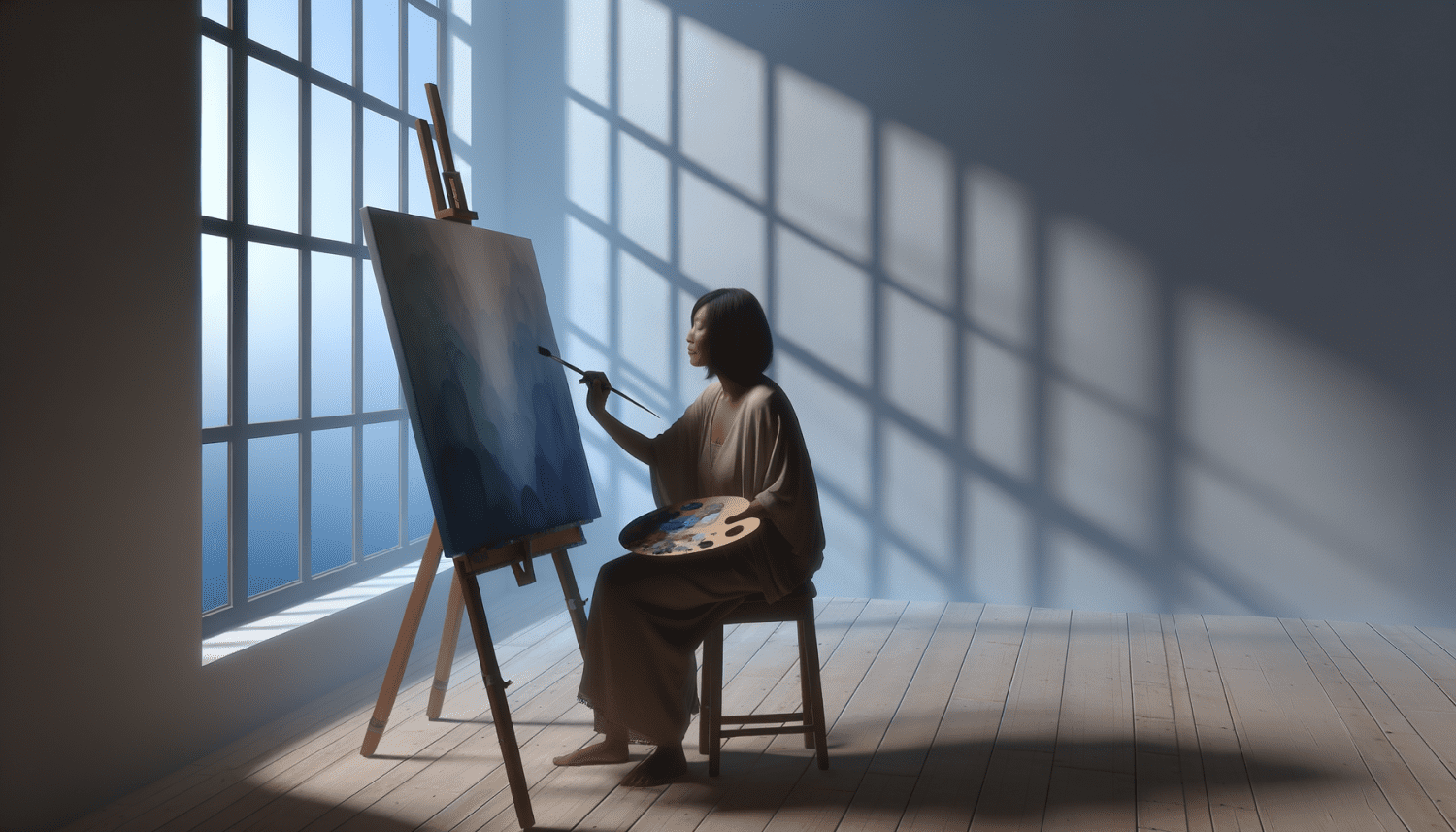
The role of art in enhancing mental wellness has gained prominence, with more and more individuals seeking creative outlets for stress relief and self-discovery. Painting, in particular, has emerged as a powerful medium of personal expression that nurtures inner peace and emotional resilience. This piece delves into how the simple act of painting can serve as a therapeutic tool, aiding those who might struggle with the complexities of verbalizing their feelings.
“painting is not merely an artistic endeavor but a dynamic form of emotional and psychological self-care.”
The Intersection of Psychology, Emotion, and the Arts
At the core of therapeutic art is a deep connection between color, emotion, and psychological well-being. The field of color psychology explores how various hues can evoke emotional responses and influence mood. From the calming blues to the vibrant energies of red or yellow, each color we choose to apply to the canvas provides a glimpse into our internal world without the need for words.
Engaging in painting offers a unique opportunity to tap into these emotional correlations with color, enabling individuals to explore and express their innermost thoughts and feelings. The principles of color psychology suggest that the shades and combinations we are drawn to in our art can reflect, or even alter, our mental state.
Embracing Color to Unveil Emotional Well-Being
The colors selected by an artist do more than fill a canvas; they can be conscious or subconscious indicators of their emotional landscape. In therapeutic settings, art therapists encourage their clients to observe the colors that draw their attention or which they shy away from. These preferences are more than aesthetic; they’re often closely tied to an individual’s emotional needs and psychological health.
Chromatic selection is pivotal for anyone venturing into painting as a form of self-care. As we journey through different emotional phases, from tranquil greens signaling growth to the passionate flush of pink, our color choices map out a rich tapestry of personal growth and healing. New Yorkers, at the heart of a bustling and vibrant metropolis, find in these hues a quiet dialogue with the self, often reflecting the contrasts they live daily.
Painting as a Sensory Experience
Aside from the psychological nuances of color, painting is also a sensually rich experience. The feel of a brush between the fingers, the smoothness of paint gliding across a canvas, and even the scent of watercolors or oils can become deeply engaging. This multi-sensory engagement has been known to promote relaxation and reduce stress levels, offering an immersive escape from the fast-paced demands of modern life.
For individuals from Brighton to Pittsford to Amsterdam, NY, the act of painting fosters mindfulness, allowing them to ground themselves in the physical sensations of the moment. It urges a release from the torrents of past regrets or future anxieties, focusing attention on the strokes and patterns unfolding in the here and now.
Painting: A Non-Verbal Avenue for Emotional Expression
For many individuals, particularly those navigating complex emotional landscapes, articulating thoughts and feelings can be a daunting task. Painting emerges as a silent yet profound communicator, allowing for emotional catharsis without the necessity for speech. This non-verbal form of therapy can be especially meaningful for the Spotted Rabbit Studio community in New York, including members of the LGBTQIA+ population and those experiencing neurodivergence, where traditional modes of communication may pose challenges.
Through expressive brushwork and the array of colors at their disposal, individuals find a voice in the strokes and imagery that surface spontaneously. In sharing the stories of those who have embraced painting as a means of healing, we see the transformative power of art. Art therapy sessions, for instance, have facilitated profound breakthroughs for individuals grappling with PTSD and BPD, offering relief and a new avenue for expression.
Regular Painting as a Keystone of Self-Care
The benefits of integrating painting into routine self-care practices are manifold. Consistent engagement with painting can steadily build a sanctuary of serene introspection, contributing positively to an individual’s mental hygiene. At Spotted Rabbit Studio, this practice echoes the understanding that healing is not a one-time event but an ongoing process. A brush in hand becomes a tool for maintaining emotional equilibrium amid the trials of daily life.
Embracing the Craft: Beginning the Therapeutic Art Journey
Taking that first step into the world of therapeutic painting does not require expertise or expensive materials. It starts with the simple intention to create and the willingness to listen to one’s inner narrative. Here are humble pieces of advice for New Yorkers looking to start:
- Choose supplies that feel right for you, whether it’s watercolors, acrylics, or colored pencils. Local art stores in the service area offer a range of materials that cater to every budget and preference.
- Carve out a time and space where you can paint without interruptions. It doesn’t have to be a studio; a quiet corner with enough light can be just as inviting.
- Let go of judgments about the ‘quality’ of your artwork. It’s the process, not the product, that harbors therapeutic value.
Overcoming Artistic Hurdles
Embarking on a creative journey entails confronting internal critics and perfectionist tendencies. In the realm of therapeutic painting, these challenges can impede the fluidity of emotional expression. Spotted Rabbit Studio encourages embracing imperfection as a vital component of the creative and healing process. Recognizing that each brushstroke is a step towards understanding oneself mitigates pressures to ‘perform’ artistically and instead redirects focus toward personal growth and self-compassion.
Enhancing Healing: The Role of Professional Art Therapy
While painting can be a powerful self-care practice, there are times when professional guidance can significantly enhance its therapeutic effects. Art therapists, like those at Spotted Rabbit Studio, are trained to support clients in exploring their creative expressions and using them to work through emotional challenges. These professionals understand the ways in which varied artistic mediums can complement traditional therapeutic methods such as Cognitive Behavioral Therapy (CBT) and psychodynamic therapy, creating a holistic approach to mental health.
For individuals battling complex issues like PTSD, BPD, or dissociative disorders, the collaboration between art therapy and other mental health treatments can open pathways to healing that might otherwise remain inaccessible. It is crucial for those considering art therapy to recognize signs that they might benefit from professional involvement, such as a desire for deeper exploration of their artwork or feeling stuck within their current therapeutic practices.
The Vitality of Creativity in Personal Growth
To summarize, painting is not merely an artistic endeavor but a dynamic form of emotional and psychological self-care. Through the lens of color psychology, we begin to understand the impact colors have on our mood and overall well-being. The act of painting enables individuals to communicate non-verbally, transcending the constraints of language to express the inexpressible. It fosters a mindful presence that can alleviate stress and promote sensory connectivity.
This article has highlighted the ways in which painting, whether as a solitary activity or a group experience, can be integrated into self-care regimes to foster ongoing mental health maintenance. We’ve discussed the importance of overcoming artistic challenges and the value of imperfection in the creative process. Moreover, the support of art therapists has been identified as a valuable resource for those looking to deepen their therapeutic journey.
Creativity in its essence is boundless and enriches life in immeasurable ways. For New Yorkers who choose the brush and canvas as companions on their path to healing, inner peace becomes an attainable, vivid experience. Painting is more than color and form—it is a vibrant language of the soul and a profound narrative of the human experience.
Share Your Journey and Connect
We invite you to share your own experiences with painting and its therapeutic effects. Engage with the Spotted Rabbit Studio community, whether online or within the diverse neighborhoods of Brighton, Pittsford, or Amsterdam, NY. Your story could resonate with someone on a similar path and inspire them to uncover their own color of healing.
Interested in discovering how painting can be a transformative tool for your mental wellness and inner peace? Reach out to us today and embark on a journey of creative healing and self-discovery through the power of art therapy.
